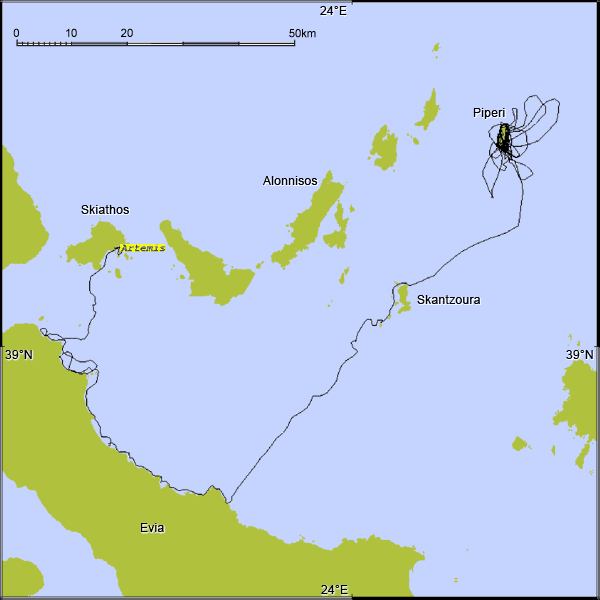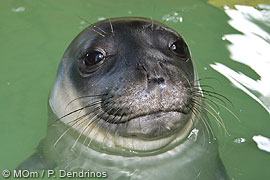

 |
||
 |
||
Vol. 12 (2): November 2009 |
||
Tracking ArtemisMaking sense out of a young seal’s deathPanagiotis Dendrinos and Emily JosephMOm/Hellenic Society for the Study and Protection of the Monk Seal
What went wrong? In order to answer that question, and shed light on events leading up to her death, MOm experts immediately assembled all available scientific data, also drawing on their years of experience in monk seal research and rehabilitation. The biologists drew information from three main sources:
A detailed necropsy was obviously the most valuable tool that the biologists could have to determine the cause of death. For that reason, MOm, in collaboration with the port police of Skiathos, transported the dead animal on the same day to the Biological Department of the University of Athens, where a full necropsy was performed the following morning. Despite the biologists’ experience, it was decided that the necropsy should be performed by a specialist in marine mammal necropsies and pathology. Professor Thijs Kuiken of Erasmus University in Rotterdam (a collaborating institution of MOm) subsequently travelled to Athens specifically for this task. The results of the necropsy showed clearly that the animal, up until her death, was healthy and was feeding regularly, having the appropriate weight for her age. It also became apparent that Artemis died from an acute pulmonary oedema which, in all probability, resulted from drowning. The fresh food found in her stomach and digested remains provided explicit evidence that her death had been sudden. The only possible cause for a healthy marine mammal to drown would be if it were forced for some reason to remain at depth against its will and beyond the time limits that it can physiologically remain without oxygen. The most common case for such an event is the entanglement of an animal in fishing gear (mainly nets). Do other data support the conclusion drawn from the necropsy?
A few hours before her release, MOm’s biologists, in collaboration with experts from the Sea Mammal Research Unit of the UK, fitted Artemis with a recording and transmitting device designed specifically for seals. The device continuously records data drawn from the activity of the animal (geographic position, duration and depths of dives, duration of haul out, etc.). What did this data have to offer on Artemis’ sudden death? Did it support the conclusion reached by the necropsy? In point of fact, the device performed flawlessly from the moment of the seal’s release. The data clearly demonstrates that Artemis was a healthy and energetic animal that, after a successful rehabilitation and a period of adjustment, behaved as a monk seal would be expected to in her natural environment. In the month following her release at the island of Piperi, Artemis explored a large geographic region, passing from Skantzoura Island to the adjacent coast of Evia, advancing north-west and finally crossing over to Skiathos (see map), a combined straight-line distance of approximately 150km. Since the day of her release (11.04.2009) until her death on 13/14 May 2009, the young seal performed almost 9700 dives, many of which reached depths of more than 100 metres, as well as a record dive on 09.05.2009 of 191 metres. 
Since 1990 MOm organises and runs a national Rescue and Information Network to monitor and respond to sick, wounded and orphaned Mediterranean monk seals. Activities of the Network also include collecting data on the health of seal populations in Greece, locating dead animals, performing necropsies, and determining cause of death. One significant finding from this effort is that almost half (47%) of the juvenile seals found dead in Greek seas and coasts are drowned as the result of entanglement in fishing gear. Fitting seamlessly together, the three pieces of the puzzle provide a clear picture of the life and death of Artemis.
|
 |
|
|
|
Artemis is the second orphaned pup where MOm biologists were able to record in detail post-release behavioural activity. The first seal, “Dimitris”, an orphaned male pup that was released in May 2004 following rehabilitation on Alonnisos. Dimitris sent data for almost five and a half months (until transmissions ended with the transmitter being dislodged, as intended, with the animal’s first moult) [see Orphaned seal criss-crosses the Sporades Marine Park, sets new diving record, TMG 7(2): November 2004 and Final farewell from Dimitris, TMG 8(1): May 2005].
Dimitris’ data, along with those of Artemis, were also important in another respect: they proved that rehabilitation processes and protocols followed by MOm in the care of orphaned seals are effective. Following their rehabilitation, both animals demonstrated “natural” behaviour, in terms of their movement in the marine environment and in the recovery of food.
b) Protected regions and national measures of protection:
Data from both seals also clearly demonstrate that Mediterranean seals, from a very young age, can already travel extensive distances and dive to impressive depths – and surely beyond the limits of protected regions. Therefore, the establishment and correct management of protected areas, particularly around core reproduction zones, must be a key consideration in the protection of the species. Also essential is the application of management measures at the national level for the mitigation of threats to the species posed by fisheries interactions. These threats also require measures and action at the governmental level, such as those proposed in MOm’s EC-funded MOFI programme; a four-year project carried out in collaboration with other institutions that for the first time investigated the problems of interactions between marine mammals and fisheries on a national level.
While we may be virtually certain that such interactions can never be eliminated entirely, specific steps can be taken to mitigate them. While tragically too late for Artemis, such measures could do a lot to save other young monk seal lives.
Dendrinos, P., A.A. Karamanlidis, E. Androukaki and B.J. McConnell. 2007. Diving development and behavior of a rehabilitated Mediterranean monk seal (Monachus monachus). Marine Mammal Science. 23 (2): 387-397. [Abstract PDF  7KB]
7KB]
Copyright © 2009 Panagiotis Dendrinos, Emily Joseph, The Monachus Guardian. All Rights Reserved |